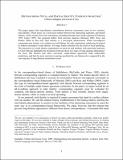Distinguishing total and partial identity: Evidence from Chol
Author(s)
Gallagher, Gillian; Coon Burgess, Jessica Louise
DownloadCoon_Distinguishing Total.pdf (458.9Kb)
PUBLISHER_POLICY
Publisher Policy
Article is made available in accordance with the publisher's policy and may be subject to US copyright law. Please refer to the publisher's site for terms of use.
Terms of use
Metadata
Show full item recordAbstract
This paper argues that long-distance assimilations between consonants come in two varieties: Total identity, which arises via a non-local relation between the interacting segments; and partial identity, which results from local articulatory spreading through intervening segments (Flemming 1995; Gafos 1999). Our proposal differs from previous analyses (Hansson 2001; Rose and Walker 2004) in that only total identity is a non-local phenomenon. While non-adjacent consonants may interact via a relation we call linking, the only requirement which may be placed on linked consonants is total identity. All single feature identities are the result of local spreading. The interaction of a total identity requirement on ejectives and stridents with anteriority harmony in Chol (Mayan) highlights the distinction between these two types of long-distance phenomena. We show that theories that allow non-local, single-feature agreement make undesirable predictions, and that the more restrictive typology predicted by our framework is supported by the vast majority of long-distance assimilation cases.
Date issued
2009-08Department
Massachusetts Institute of Technology. Department of Linguistics and PhilosophyJournal
Natural Language and Linguistic Theory
Publisher
Springer Science + Business Media B.V.
Citation
Gallagher, Gillian, and Jessica Coon. “Distinguishing total and partial identity: Evidence from Chol.” Natural Language & Linguistic Theory 27 (2009): 545-582.
Version: Author's final manuscript
ISSN
0167-806X